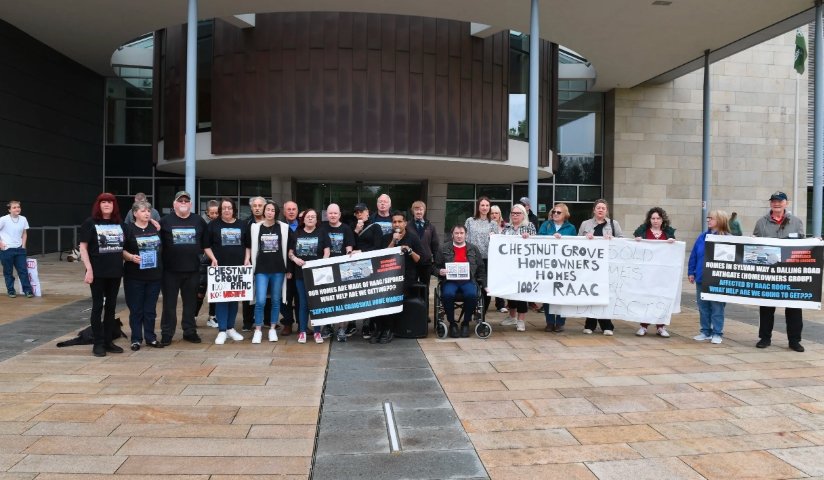Dozens of families gathered outside the Scottish Parliament this week, not in celebration or protest for political points — but in desperation. They were sold homes that are now structurally unsound, potentially unsafe, and entirely unaided by the system.
“We Were Never Told”: Homeowners in Crisis Over RAAC
On a grey Wednesday morning in Edinburgh, the voices of homeowners from across Scotland echoed off the stone walls of Holyrood.
From West Lothian to Dundee, they carried signs, photos of cracked ceilings, and tales of betrayal. At the heart of it all: RAAC — Reinforced Autoclaved Aerated Concrete — a now-infamous building material once hailed as innovative but now widely condemned as dangerously unstable.
These weren’t renters or public housing tenants. Most were people who used the Right to Buy scheme to purchase ex-council homes. For them, homeownership was a milestone — often hard-earned and long-dreamed.
But what they got, they now say, was a time bomb.

How RAAC Slipped Through the Cracks
RAAC isn’t new. It was used extensively from the 1950s through the early 1990s — praised for being cheap and lightweight. But over time, the material has proven alarmingly prone to cracking, sagging, and even collapse with little warning.
Schools were shut down. Hospitals were reinforced. Councils scrambled to inspect and mitigate damage in public buildings.
But no such urgency ever reached Scotland’s private homeowners.
Here’s the problem in plain terms:
-
Local authorities sold ex-council homes to private individuals — often vulnerable or on low incomes.
-
RAAC issues were not disclosed during sale, despite mounting evidence that some councils knew the material posed safety risks.
-
Once sold, the homes became the full legal and financial responsibility of the buyer.
And with no safety net.
One sentence here: They bought homes and inherited risk — unknowingly and unprotected.
Petition PE2150: A Call for Structural Justice
Campaigner Wilson Chowdhry, who chairs the UK RAAC Campaign Group, submitted Petition PE2150 to the Citizen Participation and Public Petitions Committee this week.
The ask is both technical and powerful: expand the powers of the Scottish Housing Regulator (SHR) or create a new watchdog altogether. The goal? To ensure private owners of ex-council properties aren’t hung out to dry when structural issues like RAAC emerge.
Right now, the SHR only serves social tenants — those renting from councils or housing associations. Everyone else is out of scope.
And that includes people like:
-
Pensioners living alone in their 80s
-
Single parents with school-age kids
-
Low-income families who saved for decades to buy a “secure” home
Without a regulator to step in, support has been scattershot — or non-existent.
Real People, Real Cost, Real Consequences
The scale of disruption is wider than many realise.
In Tillicoultry, residents were evacuated without clear next steps.
In Glenrothes, homeowners discovered RAAC through independent inspections — and were left to foot the bill.
In Aberdeen, a couple nearing retirement found their home devalued to nearly zero overnight.
Meanwhile, local councils frequently propose remedial work costing £30,000 to £50,000 — amounts most affected households simply cannot afford. Some are now facing bankruptcy. Others may be forced to walk away from their homes entirely.
And here’s the kicker: many of these buildings were knowingly sold by councils who, evidence suggests, had access to internal assessments of structural risks linked to RAAC.
A System Designed to Look Away?
The frustration is clear — and it’s building.
Chowdhry’s petition makes one core point: when homes fall apart due to known design risks that weren’t disclosed, it shouldn’t just be “bad luck” for the buyer. There needs to be a regulatory bridge — someone empowered to investigate, intervene, and mediate.
But that bridge doesn’t currently exist.
The Scottish Government’s focus has, up to now, been firmly on public buildings — with no dedicated programme addressing the growing number of private homeowners stuck in affected properties.
The difference in outcomes is jarring. In public housing, tenants are moved, buildings are inspected, structural repairs are funded. In private housing? You’re on your own.
And the lack of AIS-style oversight — similar to the boat tracking issues in marine conservation — makes it even harder to quantify how widespread RAAC truly is in privately owned ex-council homes.
Forgotten Victims of a National Crisis
This is no fringe issue.
Tens of thousands of homes across the UK were built with RAAC components. Scotland has more than its fair share. Many of these are now owned by individuals who had no hand in the construction, no idea of the material risk — and no institutional support.
And the impact is not just structural. It’s psychological, financial, emotional.
Some homeowners now live with constant fear — ceilings cracking, floors shifting, doors warping. Others are juggling legal battles, rising mortgage anxiety, and mental health strain.
“We didn’t buy crumbling homes,” said one protester. “We bought into a dream that turned out to be a lie.”


















